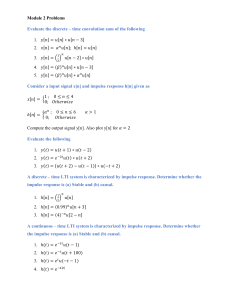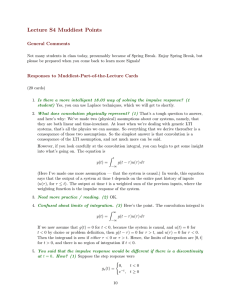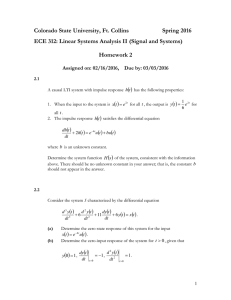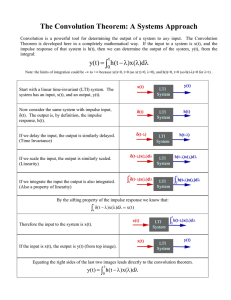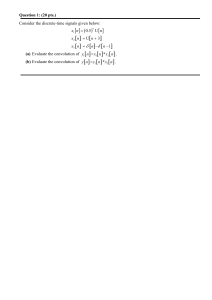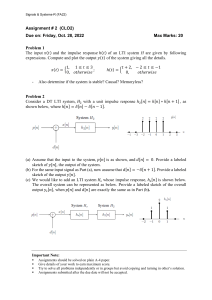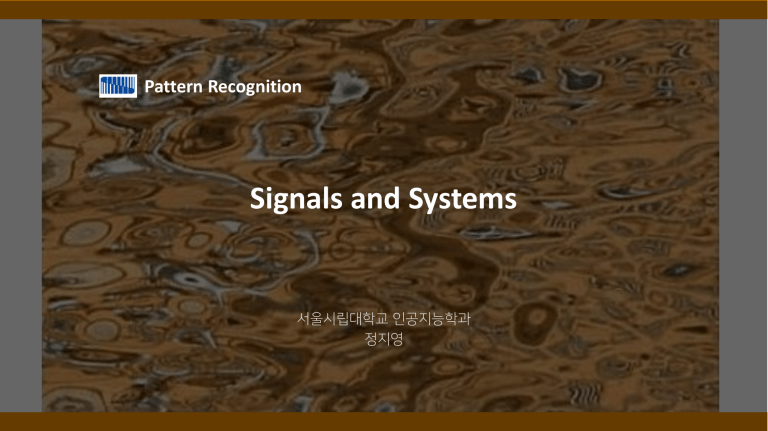
Pattern Recognition
Signals and Systems
서울시립대학교 인공지능학과
정지영
Contents
▪ Signals and Systems
▪ CT and DT Signals
▪ Signal Properties
▪ System Properties
▪ LTI Systems
▪ LTI Convolution
Reference
•Signals and Systems by Alan
Oppenheim and Alan Willsky
•Signals and Systems by Simon
Haykin and Barry Van Veen
•신호와 시스템/ 신호 및 시스템
What is a Signal?
• A signal is a pattern of variation of some form
• Signals are variables that carry information
• Electrical signals: voltages and currents in a circuit
• Acoustic signals: acoustic pressure (sound) over time
• Mechanical signals: velocity of a car over time
• Video signals: intensity level of a pixel (camera/ video) over time
How is a Signal Represented?
•Mathematically, signals are represented as a function of one or more
independent variables.
•Ex) a black-and-white video signal intensity is dependent on x, y
coordinates and time => f(x,y,t)
•First, we shall be concerned with signals which are a function of a
single variable: time.
Example: Signals in an Electrical Circuit
•The signals 𝑣𝑐 and 𝑣𝑠 are patterns of variation over time.
Continuous and Discrete-Time Signals
•Continuous-Time Signals
x(t)
‐ Most signals in the real world are continuous time, as
the scale is infinitesimally fine. (Ex: voltage, velocity)
‐ Denote by x(t), where the time interval may be bounded
(finite) or infinite.
t
•Discrete-Time Signals
‐ Some real world and many digital signals are discrete
time, as they are sampled. (Ex: pixels, daily stock price)
‐ Denote by x[n], where n is an integer value that varies
discretely.
•Sampled continuous signal
x[n]
‐ x[n] = x(nk)
‐ K is sample time
n
Signal Properties
•Periodic Signals
‐ A signal is periodic if it repeats itself after a fixed period T.
‐ x(t) = x(t+T) for all t. A sin(t) signal is periodic.
•Even and odd Signals
‐ A signal is even if x(-t) = x(t): it can be reflected in the axis at zero. A cos(t) signal.
‐ A signal is odd if x(-t) = -x(t): A sin(t) signal.
•Exponential and sinusoidal signals
‐ A signal is (real) exponential if it can be represented as 𝑥 𝑡 = 𝐶𝑒 𝑎𝑡 .
‐ A signal is (complex) exponential if it can be represented in the same form but C and a are
complex numbers.
•Step and pulse signals
‐ A pulse signal is one which is nearly completely zero, apart from a short spike, 𝛿 𝑡 .
‐ A step signal is zero up to a certain time, and then a constant value after that time, u(t).
How is a System Represented?
•A system takes a signal as an input and transforms it into another
signal
•In a very broad sense, a system can be represented as the ratio of
the output signal over the input signal.
•That way, when we “multiply” the system by the input signal, we
get the output signal.
Example: An Electrical Circuit System
Continuous and Discrete-Time Mathematical Models of Systems
• Continuous-Time Systems
‐ Most continuous time systems
represent how continuous signals are
transformed via differential equations.
‐ Ex: circuit, car velocity
• Discrete-Time Systems
‐ Most discrete time systems represent
how discrete signals are transformed
via difference equations.
‐ Ex: bank account, discrete car velocity
system
dvc (t ) 1
1
+
vc (t ) =
vs (t )
dt
RC
RC
dv(t )
m
+ v(t ) = f (t )
dt
First order differential equations
y[n] = 1.01 y[n − 1] + x[n]
v[n] −
m
v[n − 1] =
f [ n]
m +
m +
dv(n) v(n) − v((n − 1))
=
dt
First order difference equations
Properties of a System
•Causal
‐ A system is causal if the output at a time, only depends on input values
up to that time.
•Linear
‐ A system is linear if the output of the scaled sum of two input signals is
the equivalent scaled sum of outputs.
•Time-invariance
‐ A system is time invariant if the system’s output is the same, given the
same input signal, regardless of time.
How Are Signal and Systems Related (i)?
•How to design a system to process a signal in particular ways?
•Design a system to restore or enhance a particular signal
‐ Remove high frequency background communication noise
‐ Enhance noisy images from spacecraft
•Assume a signal is represented as,
‐ x(t) = d(t) + n(t)
‐ Design a system to remove the unknown “noise” component n(t), so that
y(t) ≈ d(t)
How Are Signal and Systems Related (ii)?
•How to design a system to extract specific pieces of information
from signals?
‐ Estimate the heart rate from an electrocardiogram
‐ Estimate economic indicators (bear, bull) from stock market values
•Assume a signal is represented as,
‐ x(t) = g(d(t))
‐ Design a system to “invert” the transformation g(), so that y(t) ≈ d(t)
Reminder: Continuous and Discrete-Time Signals
•Continuous-Time Signals
x(t)
‐ Most signals in the real world are continuous time, as
the scale is infinitesimally fine. (Ex: voltage, velocity)
‐ Denote by x(t), where the time interval may be bounded
(finite) or infinite.
t
•Discrete-Time Signals
‐ Some real world and many digital signals are discrete
time, as they are sampled. (Ex: pixels, daily stock price)
‐ Denote by x[n], where n is an integer value that varies
discretely.
•Sampled continuous signal
x[n]
‐ x[n] = x(nk)
‐ K is sample time
n
“Electrical” Signal Energy and Power
•It is often useful to characterize signals by measures such as energy
and power
•The instantaneous power of a resistor:
•The total energy expanded over the interval [𝑡1 , 𝑡2 ]:
•The average energy:
•How are these concepts defined for any continuous or discrete time
signal?
Generic Signal Energy and Power
•Total energy of a continuous signal x(t) over [𝑡1 , 𝑡2 ]:
•|.| denote the magnitude of the (complex) number.
•Total energy of a discrete time signal x[n] over [𝑛1 , 𝑛2 ]:
•Average power, P, is obtained by dividing the total energy by (𝑡2 − 𝑡1 )
and (𝑛2 − 𝑛1 − 1), respectively.
Energy and Power over Infinite Time
•Energy and over an infinite time interval: (-∞, ∞)
•If the integrals or sums do not converge, the energy is infinite.
•Two important (sub)classes of signals:
‐ Finite total energy (and zero average power)
‐ Finite average power (and infinite total energy)
Time Shift Signal Transformations
•A central concept in signal analysis is the transformation of one signal
into another signal. Of particular interest are simple transformations
that involve a transformation of the time axis only.
•A linear time shift signal transformation is given by: 𝑦 𝑡 = 𝑥(𝑎𝑡 + 𝑏)
▪b: a signal offset from 0
▪a: a signal stretching if |a|>1
a compression if 0<|a|<1
a reflection if a < 0
Periodic Signals
•A periodic signal is a continuous time signal x(t), that has the property,
𝑥 𝑡 = 𝑥(𝑡 + 𝑇)
where T>0, for all t.
•Examples:
‐cos 𝑡 + 2𝜋 = cos 𝑡
‐sin 𝑡 + 2𝜋 = sin(𝑡)
•For a signal to be periodic, the relationship must hold for all t.
Even and Odd Signals
•An even signal is identical to its time reversed signal.
‐ x(-t) = x(t)
‐ x(t) = cos(t)
•An odd signal is identical to its negated, time reversed signal.
‐ x(-t) = -x(t)
‐ x(t) = sin(t)
•Any signal can be expressed as the sum of an odd signal and an even
signal.
Exponential and Sinusoidal Signals
•Exponential and sinusoidal signals are characteristic of real-world signals
and also from a basis (a building block) for other signals.
•A generic complex exponential signal is of the form:
𝑥 𝑡 = 𝐶𝑒 𝑎𝑡
where C and a are, in general, complex numbers.
•Real exponential signals:
Exponential and Sinusoidal Signal Properties
•Periodic complex exponential signal
•𝑥 𝑡 = 𝑒 𝑗𝜔0 𝑡 = 𝑒 𝑗𝜔0 (𝑡+𝑇) = 𝑒 𝑗𝜔0 𝑡 𝑒 𝑗𝜔0 𝑇
•Sinusoidal signal
•𝑥 𝑡 = 𝐴𝑐𝑜𝑠(𝜔0 𝑡 + 𝜙)
•Euler’s equation
•𝑒 𝑗𝜔0 𝑡 = 𝑐𝑜𝑠 𝜔0 𝑡 + 𝑗𝑠𝑖𝑛 𝜔0 𝑡
•𝐴𝑐𝑜𝑠 𝜔0 𝑡 + 𝜙 =
𝐴 𝑗𝜙 𝑗𝜔 𝑡
𝑒 𝑒 0
2
+
𝐴 −𝑗𝜙 −𝑗𝜔 𝑡
0
𝑒
𝑒
2
= 𝐴ℜ{𝑒 𝑗(𝜔0 𝑡+𝜙) }
Exponential and Sinusoidal Signal Properties
•Complex periodic and sinusoidal signals have infinite total
energy but finite average power.
•Energy over one period:
•
•
•Useful to consider harmonic signals
•Terminology is consistent with its use in music, where each
frequency is an integer multiple of a fundamental
frequency
General Complex Exponential Signals
•When C and a are complex.
Polar form
Rectangular form
Discrete Unit Impulse and Step Signals
•The discrete unit impulse signal:
•Useful as a basis for analyzing other signals
•The discrete unit step signal:
•The unit impulse is the first difference (derivative) of the
step signal
•The unit step is the sum (integral) of the unit impulse
Continuous Unit Impulse and Step Signals
•The continuous unit impulse signal:
•It is discontinuous at t=0
•The arrow is used to denote area, rather than actual
value
•Useful for an infinite basis
•The continuous unit step signal:
CT and DT Systems
•A system takes a signal as an input and transforms it into another
signal
•A continuous-time system is a system in which continuous-time input
signals are applied and result in continuous-time output signals.
𝑥 𝑡 → 𝑦(𝑡)
•A discrete-time system transforms discrete-time inputs into discretetime outputs.
𝑥[𝑛] → 𝑦[𝑛]
x(t)
continuous
time (CT)
y(t)
x[n]
discrete
time (DT)
y[n]
28
Simple Examples of Systems
• A typical system… consider the electrical circuit example:
which is a first order, CT differential equation.
dvc (t ) 1
1
+
vc (t ) =
vs (t )
dt
RC
RC
• Examples of first order, DT difference equations:
where y is the monthly bank balance, and x is monthly net
deposit y[n] = x[n] + 1.01 y[n − 1]
• Discretized version of the electrical circuit:
RC
k
v[n] −
v[n − 1] =
f [ n]
RC + k
RC + k
• Examples of first-order linear difference equations:
• System described by order and parameters (a, b)
29
Interconnections of Systems
• Systems are generally composed of components (sub-systems).
• We can use our understanding of the components and their interconnection to
understand the operation and behavior of the overall system
x
• Series/cascade
• Parallel
y
System 1
System 2
System 1
x
y
+
System 2
• Feedback
x
+
System 1
y
System 2
30
System with and without Memory
• A system is said to be memoryless if its output for each value of the independent variable
at a given time is dependent on the input at only that same time (no system dynamics)
y[n] = (2 x[n] − x 2 [n]) 2
• e.g. a resistor is a memoryless CT system where x(t) is current and y(t) is the voltage
• A DT system with memory is an accumulator (integrator)
y[n] = k = − x[k ]
n
• and a delay
y[n] = x[n − 1]
• Roughly speaking, a memory corresponds to a mechanism in the system that retains
information about input values other than the current time.
y[n] = k =− x[k ] + x[n]
n −1
= y[n − 1] + x[n]
31
Invertibility and Inverse Systems
• A system is said to be invertible if distinct inputs lead to distinct outputs (similar to matrix
invertibility)
• If a system is invertible, an inverse system exists which, when cascaded with the original
system, yields an output equal to the input of the first signal
• E.g. the CT system is invertible:
y(t) = 2x(t)
because w(t) = 0.5*y(t) recovers the original signal x(t)
• E.g. the CT system is not-invertible
y(t) = x2(t)
because distinct input signals lead to the same output signal
• Widely used as a design principle:
–Encryption, decryption
–System control, where the reference signal is input
32
System Causality
• A system is causal if the output at any time depends on values of the output at only the
present and past times. Referred to as non-anticipative, as the system output does not
anticipate future values of the input
• If two input signals are the same up to some point t0/n0, then the outputs from a causal
system must be the same up to then.
• E.g. The accumulator system is causal: y[n] = n x[k ]
k = −
because y[n] only depends on x[n], x[n-1], …
• E.g. The averaging/filtering system is non-causal
y[n] =
1
2 M +1
M
k =− M
x[n − k ]
because y[n] depends on x[n+1], x[n+2], …
• Most physical systems are causal
33
System Stability
• Informally, a stable system is one in which small input signals lead to responses that do
not diverge
• If an input signal is bounded, then the output signal must also be bounded, if the system
is stable
x : x U → y V
• To show a system is stable we have to do it for all input signals. To show instability, we
just have to find one counterexample
• E.g. Consider the DT system of the bank account
y[n] = x[n] + 1.01 y[n − 1]
• when x[n] = d[n], y[0] = 0
• This grows without bound, due to 1.01 multiplier. This system is unstable.
• E.g. Consider the CT electrical circuit, is stable if RC>0, because it dissipates energy
dvc (t ) 1
1
+
vc (t ) =
vs (t )
dt
RC
RC
34
Definition of Time Invariance
• A system is time invariant if its behavior and characteristics are fixed over time
• We would expect to get the same results from an input-output experiment, if the same
input signal was fed in at a different time
• E.g. The following CT system is time-invariant
𝑦 𝑡 = 10𝑥(𝑡)
• Start with a delay of the input xd(t) = x(t+t0): 𝑦1 𝑡 = 10𝑥𝑑 𝑡 = 10𝑥(𝑡 + 𝑡0 )
• Now delay the output by 𝑡0 :
𝑦2 𝑡 = 𝑦 𝑡 + 𝑡0 = 10𝑥(𝑡 + 𝑡0 )
• E.g. The following DT system is time-varying
y[n] = nx[n]
• Start with a delay of the input xd[n] = x[𝑛 + 𝑛0 ]: 𝑦1 𝑛 = 𝑛𝑥𝑑 𝑛 = 𝑛𝑥[𝑛 + 𝑛0 ]
• Now delay the output by 𝑛0 :
𝑦2 𝑛 = 𝑦 𝑛 + 𝑛0 = (𝑛 + 𝑛0 )𝑥[𝑛 + 𝑛0 ]
35
System Linearity
•Let 𝑦1 (𝑡) be the response of a continuous-time system to an input 𝑥1 (𝑡) and
let 𝑦2 (𝑡) be the response of a continuous-time system to an input 𝑥2 (𝑡).
•Then, the system is linear if,
Additivity
Scaling or homogeneity
•E.g.
Linear
Non-linear
y(t) = 3*x(t)
y(t) = 3*x(t)+2, y(t) = 3*x2(t)
36
Linearity and Superposition
•Suppose an input signal x[n] is made of a linear sum of other
(basis/simpler) signals xk[n]:
x[n] = k ak xk [n] = a1 x1[n] + a2 x2 [n] + a3 x3[n] +
•then the (linear) system response is:
y[n] = k ak yk [n] = a1 y1[n] + a2 y2 [n] + a3 y3[n] +
•This is known as the superposition property which is true for linear
systems in both CT & DT
•For linear systems, an input which is zero for all time results in an
output which is zero for all time.
•Important for understanding convolution
37
Introduction to Convolution
• Definition Convolution is an operator that takes an input signal and returns an output
signal, based on knowledge about the system’s unit impulse response h[n].
x[n] = d[n]
x[n]
System
System: h[n]
y[n] = h[n]
y[n]
• The basic idea behind convolution is to use the system’s response to a simple input signal
to calculate the response to more complex signals
• This is possible for LTI systems because they possess the superposition property
x[n] = k ak xk [n] = a1 x1[n] + a2 x2 [n] + a3 x3[n] +
y[n] = k ak yk [n] = a1 y1[n] + a2 y2 [n] + a3 y3[n] +
38/17
Discrete Impulses and Time Shifts
• Basic idea: use a (infinite) set of discrete time impulses to represent any signal.
• Consider any discrete input signal x[n]. This can be written as the linear sum of a set of unit
impulse signals:
x[−1] n = −1
x[−1]d [n + 1] =
0
x[0]
x[0]d [n] =
0
x[1]
x[1]d [n − 1] =
0
n −1
n=0
n0
n =1
n 1
x[ −1] d [n + 1]
actual value
• Therefore, the signal can be expressed as:
Impulse, time
shifted signal
x[n] = + x[−2]d [n + 2] + x[−1]d [n + 1] + x[0]d [n] + x[1]d [n − 1] +
• In general, any discrete signal can be represented as:
x[n] =
x[k ]d [n − k ]
k = −
39/17
Example
• The discrete signal x[n]
is decomposed into the following additive components
x[-4]d[n+4] +
x[-3]d[n+3] +
x[-2]d[n+2] +
x[-1]d[n+1] + …
40/17
Discrete, Unit Impulse System Response
•A very important way to analyse a system is to study the output signal
when a unit impulse signal is used as an input
d[n]
System: q
h[n]
•Loosely speaking, this corresponds to giving the system a kick at n=0,
and then seeing what happens
•This is so common, a specific notation, h[n], is used to denote the
output signal, rather than the more general y[n].
•The output signal can be used to infer properties about the system’s
structure and its parameters q.
41/17
Types of Unit Impulse Response
•Looking at unit impulse
responses, allows you to
determine certain system
properties
Causal, stable, finite impulse response
y[n] = x[n] + 0.5x[n-1] + 0.25x[n-2]
Causal, stable, infinite impulse response
y[n] = x[n] + 0.7y[n-1]
Causal, unstable, infinite impulse response
y[n] = x[n] + 1.3y[n-1]
42/17
Linear, Time Varying Systems
• If the system is time varying, let hk[n] denote the response to the impulse signal d[n-k]
(because it is time varying, the impulse responses at different times will change).
• Then from the superposition property of linear systems, the system’s response to a more
general input signal x[n] can be written as:
• Input signal
x[n] = x[k ]d [n − k ]
k = −
• System output signal is given by the convolution sum
y[n] =
x[k ]h [n]
k = −
k
• i.e. it is the scaled sum of impulse responses
43/17
Example: Time Varying Convolution
• x[n] = [0 0 –1 1.5 0 0 0]
• h-1[n] = [0 0 –1.5 –0.7 .4 0 0]
• h0[n] = [0 0 0 0.5 0.8 1.7 0]
y[n] = [0 0 1.4 1.4 0.7 2.6 0]
44/17
Linear Time Invariant Systems
• When system is linear, time invariant, the unit impulse responses are all time-shifted
versions of each other:
hk [n] = h0 n − k
• It is usual to drop the 0 subscript and simply define the unit impulse response h[n] as:
h[n] = h0 n
• In this case, the convolution sum for LTI systems is:
y[n] =
x[k ]h[n − k ]
k = −
• It is called the convolution sum (or superposition sum) because it involves the convolution
of two signals x[n] and h[n], and is sometimes written as:
y[n] = x[n] * h[n]
45/17
System Identification and Prediction
• Note that the system’s response to an arbitrary input signal is completely determined by
its response to the unit impulse.
• Therefore, if we need to identify a particular LTI system, we can apply a unit impulse
signal and measure the system’s response.
• That data can then be used to predict the system’s response to any input signal
x[n]
y[n]
System: h[n]
• Note that describing an LTI system using h[n], is equivalent to a description using a
difference equation. There is a direct mapping between h[n] and the parameters/order of
a difference equation such as:
•
y[n] = x[n] + 0.5x[n-1] + 0.25x[n-2]
46/17
Example 1: LTI Convolution
Consider a LTI system with the following unit
impulse response:
h[n] = [0 0 1 1 1 0 0]
For the input sequence:
x[n] = [0 0 0.5 2 0 0 0]
The result is:
y[n] = … + x[0]h[n] + x[1]h[n-1] + …
=0+
0.5*[0 0 1 1 1 0 0] +
2.0*[0 0 0 1 1 1 0] +
0
= [0 0 0.5 2.5 2.5 2 0]
47/17
Example 2: LTI Convolution
Consider the problem described for
example 1
Sketch x[k] and h[n-k] for any particular
value of n, then multiply the two signals and
sum over all values of k.
For n<0, we see that x[k]h[n-k] = 0 for all k,
since the non-zero values of the two signals
do not overlap.
y[0] = Skx[k]h[0-k] = 0.5
y[1] = Skx[k]h[1-k] = 0.5+2
y[2] = Skx[k]h[2-k] = 0.5+2
y[3] = Skx[k]h[3-k] = 2
As found in Example 1
48/17
Example 3: LTI Convolution
Consider a LTI system that has a step response h[n] = u[n]
to the unit impulse input signal
What is the response when an input signal of the form
x[n] = anu[n]
where 0<a<1, is applied?
n
For n0: y[ n] = a k
k =0
1 − a n +1
=
1−a
Therefore,
1 − a n +1
u[n]
y[n] =
1−a
49/17
